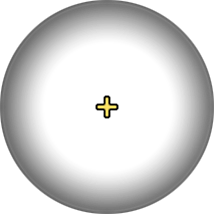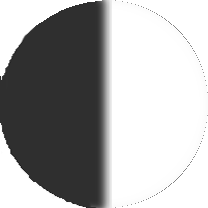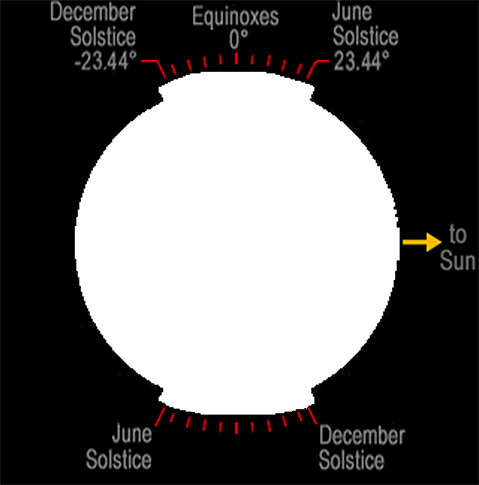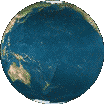

EARTH TILT, SUNRISE & SUNSET
Courtesy: Fourmilab Switzerland (to update, reload page)
View "preceding" Earth in its orbit View "trailing" Earth in its orbit
Though Earth's tilt of 23.44° "relative to its orbital plane" stays essentially fixed over many human lifetimes, its tilt "relative to the Sun" varies in a regular yearly cycle. The two large views of our planet above show its current tilt relative to the Sun, revealing which parts are presently rotating into daylight (sunrise) and darkness (sunset). In the left large view the Sun is rising (daylight is breaking) at the eastern limits of Earth's shadow. In the right large view the Sun is setting (darkness is falling) at the western limits of Earth's shadow. The vantage of both large views is from directly above 0° latitude to show the entire portions of Earth rotating into sunrise and sunset respectively.
Of course, it is Earth's annual cycle of changing tilt "relative to the Sun" that—for the most part—produces our seasons. It is also what produces the accompanying variations in Day and Night on Earth throughout the year, which continually alter local Sunrise and Sunsets Times around the world. This means that your own times of sunrises and sunsets are governed not only by your location on Earth, but additionally by the time of year.


ago, two months ago, etc. The animation below—of Earth\'s yearly orbit around the Sun—shows why this is so. It confirms that, relative to Earth's orbit and the heavens, the direction and angle of our planet's tilt does indeed re- main essentially fixed. In contrast, it is only Earth's tilt "relative to the Sun" that changes throughout the year.
In the two large views of Earth near the top, and in the Earth-rotation animation above, you will note that slightly more than half of our home planet is illuminated. This is due to the Effects of Twilight, which actually illuminate Earth somewhat beyond its "geometric" terminator, i.e. the constantly moving line that separates day from night on a planet, moon, etc. These effects also make Earth's terminator more of a darkening gradient than the harsh edge of shadow with which it is often represented. Ignoring the Effects of Twilight, the current amount of each hemi- sphere in the "direct rays" of the Sun is given above as the percent in Daylight.






The animation of Earth's orbit directly above illustrates the relationship between the Sun and our "tilted planet" throughout the year. It also provides a reference for how the two large views of Earth (nearer to the top of this page) should appear when our planet is at different points in its orbit. Each year Earth's axis tilts "toward" the Sun most greatly at two specific instants (once for each hemisphere), and least greatly at two specific instants. These occur at distinct points along Earth's orbit and define the beginnings of our seasons.
The June Solstice, the start of the Northern Hemisphere's summer and the Southern Hemisphere's winter, is the first time each year when Earth's axis tilts most greatly toward the Sun (23.44°). Our planet's North Poles will lean "toward" each other in both large views of Earth above, which are simultaneous views from "ahead of" and "behind" Earth in its orbit. At this time of year approximately 63% of the Northern Hemisphere is in daylight (its maximum for the year), compared to the Southern Hemisphere's minimum of 37%.
At both equinoxes, Earth's axis in each large view above will appear 90° vertical, because the poles are leaning neither toward nor away from the Sun. Of course, Earth is still tilted its 23.44° "relative to its orbit", but at the equinoxes that tilt is "sideways" to the Sun, as can be seen in the images both above and below. The equinoxes are the only two instants each year when both hemispheres are equally lit and—except for the Effects of Twilight
—are both essentially 50% in Daylight.
EARTH'S TILT VIEWED FROM THE SUN AT:
March June September December
Equinox Solstice Equinox Solstice
The December Solstice, the start of the Southern Hemisphere's summer and the Northern Hemisphere's winter, is the second time each year when Earth's axis tilts most greatly toward the Sun (23.44°), though this time it is the South Pole which leans "sunward". Our planet's South Poles will lean "toward" each other in both large views of Earth above, which are simultaneous views from "ahead of" and "behind" Earth in its orbit. At this time of year approximately 63% of the Southern Hemisphere is in daylight (its maximum for the year), compared to the Northern Hemisphere's minimum of 37%.
Giving rise to Earth's seasons, the difference in sunlight received by each hemisphere at various times of year is often not fully appreciated. It should be remembered that the equinoxes are the only instants each year when both hemispheres are receiving equal amounts of energy from the Sun. More pertinent to our changing seasons, and far more telling of the importance of our planet's varying tilt in its year-long orbit . . .
at either solstice the hemisphere leaning toward the Sun is receiving
roughly 70% more direct solar radiation than its counterpart!
Earth's varying tilt throughout the year can be seen from a different vantage point—i.e. directly above Earth's North Pole—on our Equinoxes, Solstices and the Sun's Apparent Motion page. And for more insight on how Earth's tilt affects different parts of our world check out our The Sun's Skypath and Six Current Views of Earth pages.
Home Intro News Gallery Sky-Gifts Bonuses Tips
Learning Ctr Help Links Credits Legal Contact Us
© 2007-
by Gary M. Winter. All rights reserved.
Interested in political cartoons and humor?
Check out The HIPPLOMATS™.
SkyMarvels, Sky Marvels, SkyMarvels.com, Current Earth Tilt, Current Earth Sunrise and Sunset Views!, Current Earth Inclination, Global Sunrise and Sunset Views, Current Locations of Sunrise and Sunset On Earth!, The Solar Analemma, the Sun's Analemma, celestiaforall, CELESTIA, astronomy, space, simulations, animations, downloadable astronomy posters, stars, planets, Inner Planets, Outer Planets, Inferior Planets, Superior Planets, moons, asteroids, comets, Oort Cloud, galaxy, galaxies, Milky Way, Andromeda, globular clusters, binaries, quasars, black holes, supermassive black holes, telescope, telescopes, planetarium, software, freestuff, satellites, add-ons, addons, scripts, eclipses, Solar Eclipses, Lunar Eclipses, Solar Eclipse Finder, Lunar Eclipse Finder, mutual eclipses, transits, occultations, Solar System, CELES-TOOLS, celeSTARrium, CELX, CELX programming, Freebies, multiple views, atronomical unit, light year, parsec, meteors, meteor showers, Perseids, Geminids, Leonids, barycenter, time, Time Zones, tides, alignments, conjunctions, oppositions, seasons, apogees, perigees, aphelion, perihelion, Earth, Luna, Mercury, Venus, Mars, Jupiter, Galilean Moons, Io, Europa, Ganymede, Callisto, Saturn, Titan, rings, Uranus, Neptune, Triton, E-MSpectrum, electromagnetic spectrum, astronaut, equinoxes, solstices, precession, rotation, spin, inclination, tilt, Ecliptic, orbits, ellipse, parabola, hyperbola
